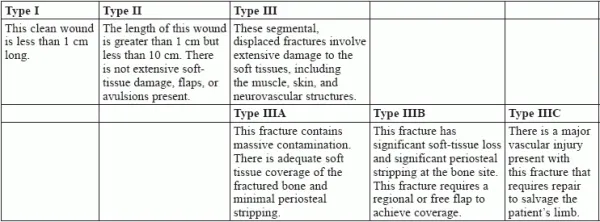Reference the Gustilo Classification for Precise Open Ankle Fracture Coding
Hint: You must know the depth of the wound and the extent of tissue damage. When you look at the podiatrist's documentation and see a diagnosis of an ankle fracture, you should go to category S82- (Fracture of lower leg, including ankle) to discover your code choices. However, once you turn to the correct place in your ICD-10 manual, you're instantly bombarded by a lengthy list of seventh characters you must add to all the codes from category S82-. Dig deeper into the meaning behind these characters and the Gustilo classification to help you master your various ICD-10 options and better grasp how to report ankle fractures. What is the Gustilo Classification? Find Out Dr. Ramon Gustilo created the Gustilo classification to help identify different types of ankle fractures, which you can find in category S82-. The Gustilo classification applies to open fractures only, and it also impacts categories S52- (Fracture of forearm) and S72- (Fracture of femur). There are three main categories of the Gustilo classification designated as Type I, Type II, and Type III. Type III is further broken down in categories A, B, and C. There is a huge difference for a Type 1 fracture versus a Type IIIC fracture with arterial damage, which is a limb-threatening injury, according to Jordan Meyers, DPM, partner at Raleigh Foot and Ankle Center and consultant at Treace Medical Concepts, Inc. in Raleigh, North Carolina. It's important to educate patients on the chance of loss of a limb and what kind of complications they could face as they recover weeks, months, and years down the road, Meyers says. With the Gustilo open fracture classification, you must make sure you get the adequate measurements of the wound and take note of how much soft tissue damage is involved, adds Ashley Nettles, DPM, podiatrist at William Jennings Bryan Dorn VA Medical Center in Columbia, South Carolina. "Also any vascular compromise is automatically a IIIC classification," Nettles says. "Being able to classify these open fractures is important in determining how to treat them." Coding Tip: You should ask yourself the following questions when you come across fracture classifications in the medical documentation, according to Angela K. Mondragon, CPC, certified professional coder at Oklahoma Sports and Orthopedics Institute in Norman, Oklahoma: Deciphering Seventh Characters for Open Ankle Fractures The ICD-10 manual does not include an explanation of the three types of Gustilo open fractures - not in terms of identifying what type of wound each type describes. However, a note under category S82- does tell you, "The open fracture designations are based on the Gustilo open fracture classification." Under this note, you will see a list of seventh characters you must add to all codes from category S82-. Editor's note: You can take a look at the chart below to understand the meaning behind the Roman numerals and characters in the Gustilo classification. Check out this seventh character list and start combing through the ankle fracture code options, so you can see where the Gustilo classification comes into play: Here are some examples of the ankle fracture ICD-10 code choices you have from category S82-: Use the following chart as a resource to help you understand how the Gustilo open fracture classification groups open fractures: Putting it all together: Now, when you see the terms "IIIA, IIIB, or IIIC," like in the descriptor for S82.841C, you'll know those letters and numbers represent the Gustilo open fracture classification.





